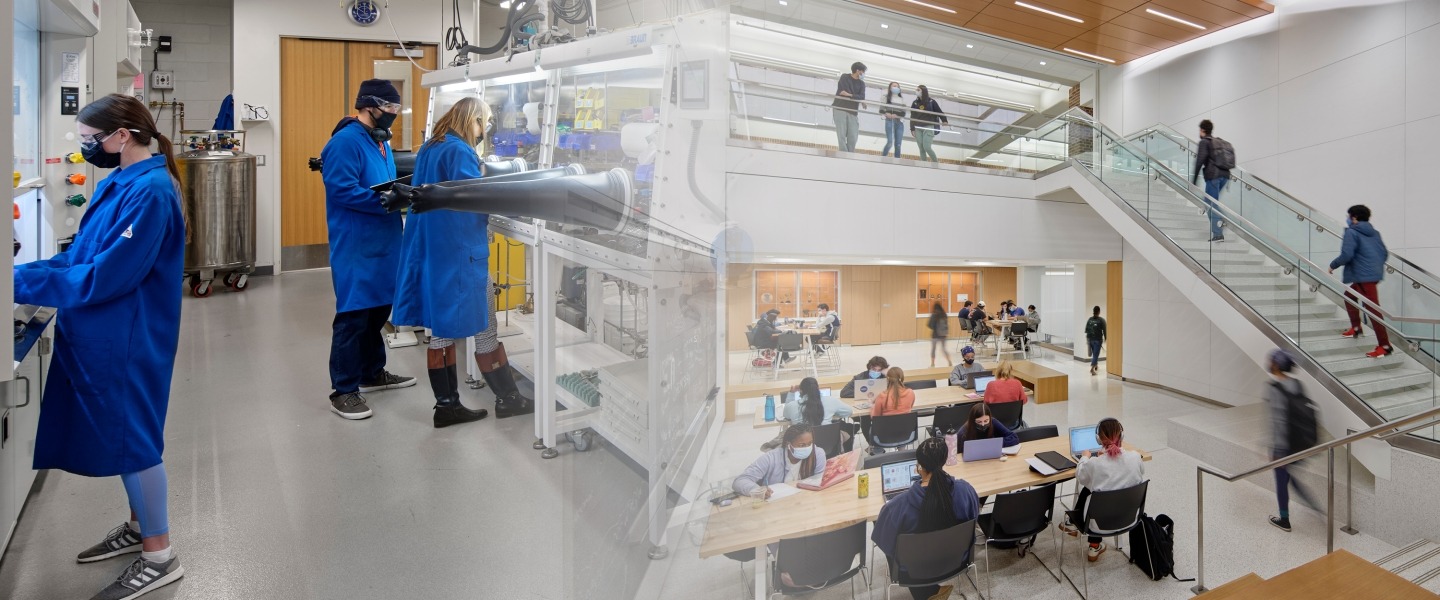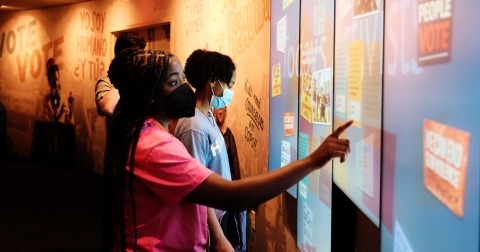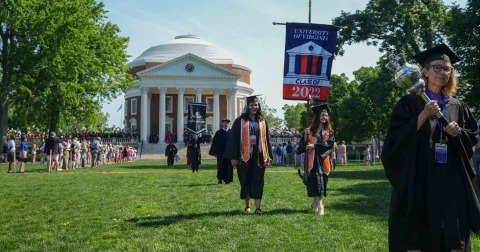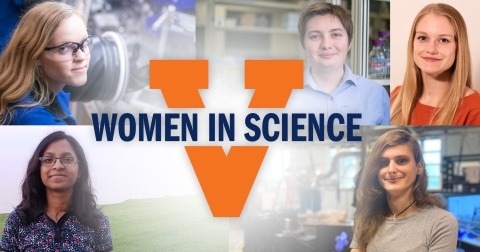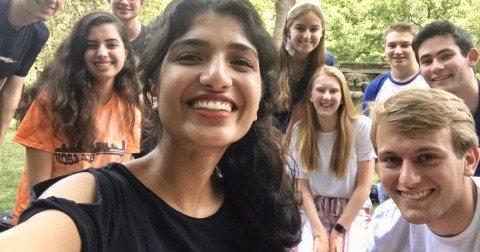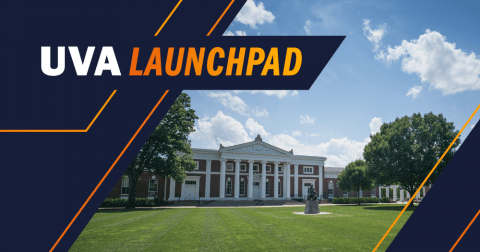The last few years have been remarkable ones for the College’s Department of Chemistry. Its researchers have won a slew of international awards and high-profile National Science Foundation grants, its graduate students are winning national recognition for their work, and its faculty are developing innovative new approaches to teaching challenging courses. And after a six-year-long renovation project, the Department welcomed students and faculty back to a state-of-the-art, LEED-certified chemistry building that will help position UVA as one of the top schools in the country for chemistry research and education.
The objectives for the six-year-long, $100 million renovation were to convert the 52-year-old building into a 21st century learning environment that allows for a higher level of collaboration and interaction between faculty, researchers and students and to upgrade the building’s capacity to support leading-edge research and teaching strategies.
 Lobby view of the University of Virginia’s state-of-the-art, LEED-certified chemistry building. Credit: Halkin Mason Photography
Lobby view of the University of Virginia’s state-of-the-art, LEED-certified chemistry building. Credit: Halkin Mason Photography
“People are doing different kinds of science than they were doing 50 years ago, and people are teaching and working in different ways – wanting to be more interdisciplinary and wanting to be more collaborative – and those were explicit aims in the redesign,” said Anna Towns, director of Space, Planning, and Management for the College, who worked with the architectural firm of Perkins & Will and the construction firm of Whiting-Turner to create a facility that could inspire this generation of scientists and those to come.
The result is a modern space with the flexibility to accommodate new ideas and future advances that will be instrumental in attracting both new students and faculty. And the project provides alumni with a host of new naming opportunities that will help make many of those advances possible.
“People are doing different kinds of science than they were doing 50 years ago, and people are teaching and working in different ways – wanting to be more interdisciplinary and wanting to be more collaborative – and those were explicit aims in the redesign.” - Anna Towns, director of Space, Planning and Management
Active-Learning Labs
Some of the most high-profile spaces in the building’s design are its active-learning classrooms.
The department recently implemented a new approach to introductory chemistry that involves both a lecture and an opportunity for students to come together in small groups to apply what they learn in the lecture hall to complex problems in chemistry. The approach has been effective at closing the learning gaps between students with different educational backgrounds, and it is improving student retention and performance for students who go on to take more challenging upper-level chemistry courses.
 Active-learning labs in UVA’s newly renovated chemistry building were designed to accommodate a group-learning approach and the use of state-of-the-art educational technology. Credit: Halkin Mason Photography
Active-learning labs in UVA’s newly renovated chemistry building were designed to accommodate a group-learning approach and the use of state-of-the-art educational technology. Credit: Halkin Mason Photography
The new classrooms facilitate group work, support the use of student laptops and other devices and feature sound systems that allow students to ask (and hear) questions in large-group settings. The system also supports closed-captioning technology for students with hearing challenges.
Student Gathering Space
With the addition of more natural lighting and comfortable gathering places, the new chemistry building is becoming a gathering place for students both in and out of the classroom, enhancing the opportunities for collaborative and informal learning.
“When I walk in there every single chair is full, every space is full. The students just really want to be there,” said Towns.
 UVA’s newly renovated chemistry building features workspaces designed to create a more cohesive and supportive STEM community. Credit: Halkin Mason Photography
UVA’s newly renovated chemistry building features workspaces designed to create a more cohesive and supportive STEM community. Credit: Halkin Mason Photography
“I see my students hanging out there, and there are informal study groups that are happening, and before, we didn’t have as many spaces where you could do that,” added Jill Venton, professor and chair of UVA’s Department of Chemistry, who feels that the new environment will create a more cohesive and supportive community.
“There’s that old mindset that you learn by going to lectures and work on the problems yourself, and that works for some people, but now we’re less likely to lose those people who could have done more if they had a little help or a little bit more structure,” Venton said.
“I see my students hanging out there, and there are informal study groups that are happening, and before, we didn’t have as many spaces where you could do that.” - Jill Venton, professor and chair of UVA’s Department of Chemistry
Maker Space and Virtual Reality Lab
To help foster a stronger student community, the renovation also incorporates a common workspace known to today’s students as a “maker space.” It features two state-of-the-art 3D printers and an adjoining virtual reality lab that will serve primarily as meeting space where students can work on group projects and presentations and that will host the extracurricular, community-building activities of science-oriented student clubs and special-interest groups.
 Maker space in UVA’s newly renovated chemistry building provides space for group work and creative collaboration. Credit: Halkin Mason Photography
Maker space in UVA’s newly renovated chemistry building provides space for group work and creative collaboration. Credit: Halkin Mason Photography
Teaching Labs
Changes to the chemistry building’s teaching laboratories also reflect the more modern approach to chemistry education that focuses on collaborative learning. The new labs feature video screens to enhance communications in an active environment, and they contain updated equipment, improved safety and accessibility features and group-oriented workspaces.
“Today there’s a much bigger focus on problem solving skills and critical thinking,” said Lisa Morkowchuk, an assistant professor who teaches general chemistry. “It’s really the group work that’s facilitating the growth of those skills in our students – collaborating and working together to solve problems and putting together a cohesive product that everyone in the group is proud of – and the important thing is having a physical layout to the room where everyone in the group can see everything that’s going on and can really be involved.”
 Renovated teaching labs feature updated equipment and enhanced communications technology to support a group-oriented approach to the study of chemistry. Credit: Molly Angevine
Renovated teaching labs feature updated equipment and enhanced communications technology to support a group-oriented approach to the study of chemistry. Credit: Molly Angevine
According to Morkowchuk, it’s a combination that is equipping students for the challenges they are most likely to face in their future careers.
Research Labs
Upgrades to research facilities are also benefitting the research efforts of faculty and their graduate students.
“The safety designs are a significant upgrade and help to ensure that UVA is providing the safest possible work environment to our students, postdocs and faculty,” said Brent Gunnoe, Commonwealth Professor of Chemistry and winner of the 2022 George A. Olah Award in Hydrocarbon or Petroleum Chemistry. “Also, the laboratory space is optimized for our research needs, which substantially enhances efficiency and progress. The renovated lab space, office space, meeting rooms, and kitchen areas also enhance our ability to recruit talented graduate students and postdocs.”
 Upgrades to research spaces in the new renovated UVA chemistry building are making cutting-edge research safer and more efficient. Credit: Halkin Mason Photography
Upgrades to research spaces in the new renovated UVA chemistry building are making cutting-edge research safer and more efficient. Credit: Halkin Mason Photography
With a full semester complete, the response to the new space from students and faculty alike has been good, Venton said.
“People are enjoying the new spaces, and they’re starting to see how it’s enabling better research and better teaching,” Venton said. “We’re starting to see our students collaborating in the student spaces, and we’re finally to the point where we’re using them to do cutting edge science.”

